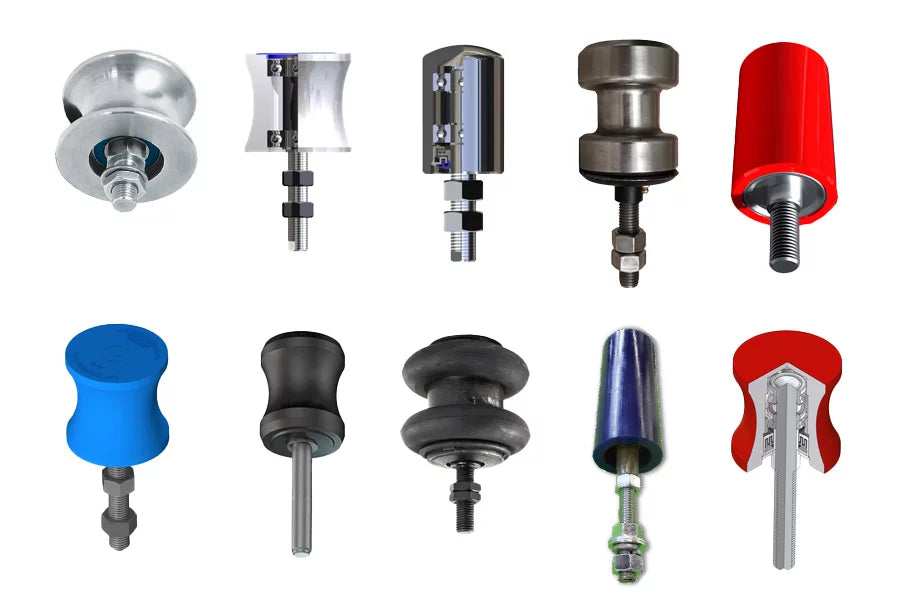Side guide rollers are essential components in conveyor systems, ensuring proper belt alignment and reducing maintenance issues. This guide provides comprehensive insights into their functions, materials, and selection criteria.
What Are Side Guide Rollers?
Side guide rollers maintain the alignment of conveyor belts, preventing drift and minimizing wear on belt edges. They are strategically placed along the conveyor path to ensure smooth operation and reduce material spillage.
Materials Used in Guide Rollers
| Material | Abrasion Resistance | Fatigue Resistance | Sustainability | Thermal Conductivity | Toughness | Corrosion Resistance |
|---|---|---|---|---|---|---|
| Mild Steel | ★★★★★ | ★★★★★ | ★★★★ | ★★★ | ★★★★★ | ★★★ |
| Polyurethane | ★★★★ | ★★★★ | ★★★ | ★★ | ★★★ | ★★ |
| Rubber | ★★★ | ★★★ | ★★ | ★★ | ★★★ | ★★ |
| Plastic | ★★ | ★★ | ★★ | ★ | ★★ | ★ |
Note: Ratings are based on general material properties and may vary depending on specific formulations and operating conditions.
Steel Guide Rollers
Pros:
- Excellent wear and fatigue resistance
- Efficient heat dissipation
Cons:
- Variable corrosion resistance; unprotected steel may rust
Manufacturers:
- Rulmeca (Italy) - Global availability
- PROGUIDE (Canada) - Available in Canada, USA, South America
- Krumscheid (Germany)
- Kuepper (Germany)
Polyurethane Guide Rollers
Pros:
- Superior abrasion and corrosion resistance
- Good impact resistance
Cons:
- Poor heat conductivity; may overheat in high-friction scenarios
Manufacturers:
- PPI (USA) - Available in Canada, USA, South America
- Kinder (Australia) - Global availability
- Luff Industries (Canada) - Available in Canada, USA
- American Eagle Manufacturing (USA)
Rubber Guide Rollers
Pros:
- Effective vibration damping
- High elasticity
Cons:
- Shorter service life in high-stress conditions
Manufacturers:
- Everpads (Taiwan)
Plastic Guide Rollers
Pros:
- High corrosion resistance
- Adequate toughness and wear resistance for light-duty applications
Cons:
- Moderate service life; less durable in extreme environments
Manufacturers:
- Kuepper (Germany)
Frequently Asked Questions
Why are guide rollers essential for alignment?
Guide rollers are strategically positioned along the conveyor at key points including turns, transitions, and loading zones. Their placement prevents the belt from rubbing against the conveyor frame, thereby avoiding edge damage. This setup improves the overall conveyor efficiency and safety by reducing spillage and uneven wear.
How do you measure guide rollers to ensure the belt is properly aligned?
- Roller Diameter: Ensure the roller’s outer diameter aligns with the conveyor’s specifications to provide adequate contact with the belt edges.
- Face Length: Measure the contact surface length of the roller, which influences the steering force applied to the belt.
- Mounting Bracket Dimensions: Check the size and bolt hole spacing of the brackets to ensure they fit securely to the conveyor frame.
- Clearance from Belt: Aim for approximately a 1-inch gap between the roller and the belt when centered without interference.
Conclusion
Selecting the appropriate side guide rollers is crucial for the efficient operation of conveyor systems. By understanding the materials and factors involved, you can make informed decisions that enhance performance and reduce downtime.

